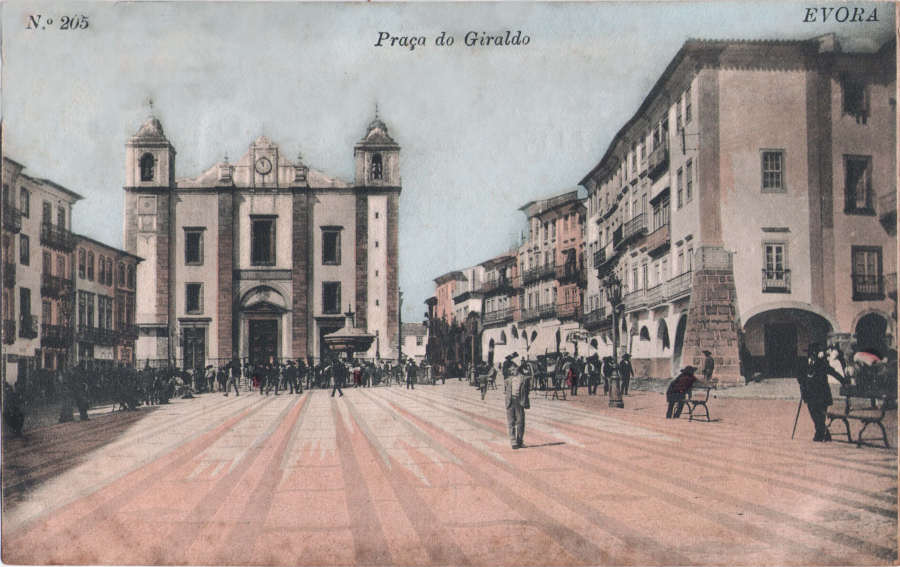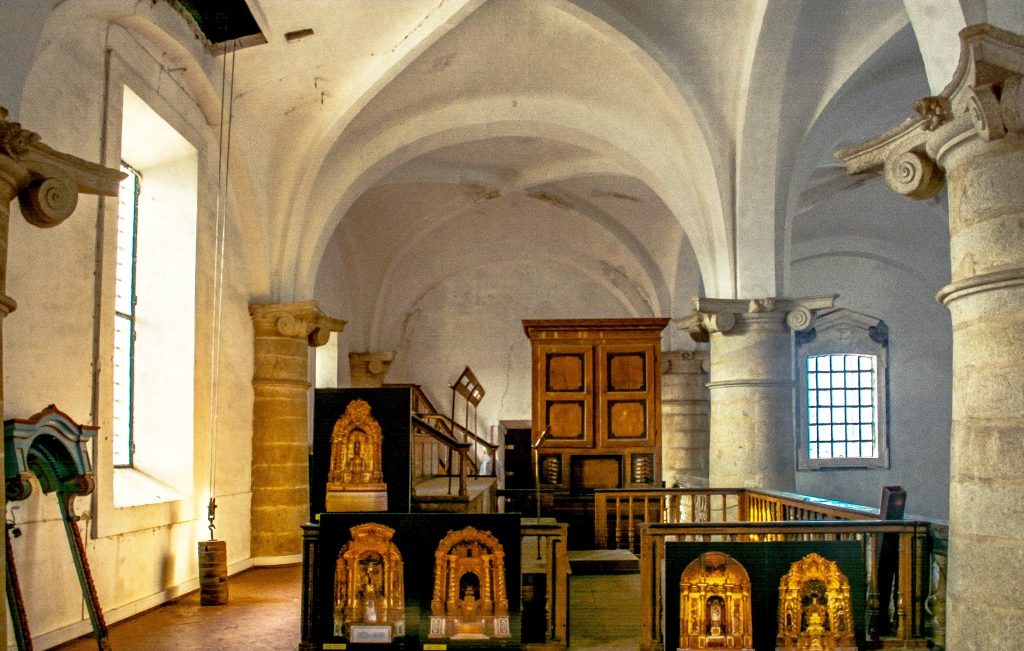
Organ activity in the Church of Santo Antão, Évora, in the 1570s
The Church of Santo Antão (dedicated to St Anthony, Abbot) was one of the main construction projects of the Cardinal D. Henrique during his government as Archbishop of Évora. During Medieval times it is referenced as the Church of Santo Antoninho in the city’s main square, annexed to the hospital and lodging facilities in charge of the Order of the Temple.
The Collegiate was founded on 18 April 1333 and the provision of the first raçoeiros of the community in 1380 with a vicar and six beneficiados (Henriques, 2017: 356). In the sixteenth century the archbishop of Évora D. João de Melo created a rectorate in the church on 28 April 1565 being the first prelate to designate himself as prior of Santo Antão. Its second prior was the Cardinal D. Henrique (Fonseca, 1728: 218). During his first stage as archbishop of Évora D. Henrique began the preparations to build a new temple on the main square, over the small Medieval Church of Santo Antoninho. Preparatory works by the royal architect Miguel de Arruda were made in 1548. The author of the project was the stone mason master from Évora Manuel Pires which supervised the construction work from 1557 to 1563.
On 17 April 1568 an earthquake destroyed much of the church’s stone ceiling. Two years later D. Henrique ordered the Évora architect Afonso Álvares to work on repairing the damage in the structure of the church. During this time, it is referenced that a Roman triumph arch located in the square was demolished, although there are no proofs of this construction has ever existed there (Fonseca, 1728: 218).

The construction of this reparation work was entrusted to the stone mason master Brás Godinho. Of the works carried under his supervision we highlight the plastering of the interior walls, the finish of the ceiling in 1572, being all work finished in 1577 (Fonseca, 1728: 218).
As the case of the other Collegiate churches of Évora (São Mamede and São Tiago) the Church of Santo Antão has remained in a musical secondary plan when compared with the activity of the Cathedral and its choirboys college.
As in other Collegiate churches, the musical investments were made by the Bishop or Archbishop of the city in question. One such example, close to the one presented in this text, comes from Granada in 1614. In that year the archbishop ordered the repairing of the organ from the Church of Santiago, noting that it was in much disrepair and was lacking many pipes, to Juan Crespo Marmolejo. The supervision of this work was entrusted to Martín de Caracuel, beneficiado in Santiago (Ruiz Jiménez, 2016).
In 1571, with the church still in the repairing works, the Évora Cathedral Chapter determined the payment of the small organs (here identified as plural but certainly referring to a single instrument) of the Collegiate church of Santo Antão to a certain Francisco Varela, organist (Conde, 2016).
This payment was to be confirmed in a provision by the archbishop of Évora D. João de Melo dated from 2 October 1572 where we find some information regarding organ activity in the Collegiate church. In the document Manuel do Vale, beneficiado at Santo Antão, was ordered by the archbishop to pay the remaining 6.600 reis to the organist Francisco Varela who had built the organ for the church. Here we assume that Francisco Varela besides organist was also an organ builder. According to the document, Varela had built the Collegiate organ for a total of 40.000 reis according to a previous deed cited in the provision.
On the receipt following the provision signed by Francisco Varela on 8 October 1572, the organist stated that he had received the remaining 6.600 reis for building the organ of the Collegiate church of Santo Antão.
Varela’s receipt also mentions Gaspar Lopes as witness, who “played the organs of the Church of Santo Antão” at that time. This suggests that Francisco Varela was not organist at Santo Antão being contracted by the Cathedral Chapter to build an organ for the Collegiate.

Luís Cardoso, also organist and organ builder, was cited in a provision from the archbishop authorizing the payment for repairing and tuning the Collegiate organ.
In 1597 there is a reference to a certain Gaspar Marim “who had repaired the organs of Santo Antão” by the Évora Cathedral Chapter
This 1570 organ is probably, in part or totally, lost since in 1745 a new organ was bought to of Santo Antão by the Collegiate rector Domingos Cardoso to an unspecified organ builder, and two years later it was being repaired (Conde, 2016).

We were unable to locate any biographical references regarding Francisco Varela, Gaspar Lopes, Luís Cardoso, or Gaspar Marim. This might be a consequence of the secondary place the collegiates occupied when compared to the Cathedral in the musical universe of Évora. In his extensive listing of musicians of the sixteenth and seventeenth centuries, Túlio Espanca does not mention any of the four both on the organists and organ builders section nor the more general musicians one. The author referrers several known organists and organ builders contemporaries to the ones from this study, mostl active in the Cathedral, such as Manuel de Barbança or Baltazar Estaço (Espanca, 1948: 145-146). Their names do not appear on the general musicians lists, although we find several ones with ties to Santo Antão’s parish life such as Barbança who was testimony to a marriage in 1581 in which the shawmn player João de Contreiras was also testimony (Espanca, 1948: 164).
During this period (after 1575) Manuel Mendes was chapel master at Santo Antão, having certainly met the above-mentioned musicians (Henriques, 2017: 356). Although not referred in much of the documentation, the activity of Francisco Varela, Gaspar Lopes, Luís Cardoso, and Gaspar Marim in the Collegiate of Santo Antão constitutes an important contribution for the widening of the knowledge of music and musicians, in the present case organists and organ builders, in the collegiate churches of the urban soundscape of the city in general.
BIBLIOGRAPHY
CONDE, A. (2016). Ambiência monástica e prática litúrgico-musical pós-tridentinas no mosteiro de S. Bento de Cástris. In Conde, A. and Gouveia, A. C. (Dir.). Do Espírito do Lugar – Música, Estética, Silêncio, Espaço Luz. I e II Residências Cistercienses de São Bento de Cástris (2013, 2014). Évora: Publicações do Cidehus. https://books.openedition.org/cidehus/1985
ESPANCA, T. (1948). Alguns artistas de Évora nos séculos XVI-XVII. A Cidade de Évora, 15-16, 131-287.
FONSECA, F. da (1728). Evora Gloriosa. Epilogo Dos quatro Tomos da Evora Illustrada, que compoz o R. P. M. Manoel Fialho da Companhania de Jesu. Roma: Na Officina Komaarekiana.
HENRIQUES, L. (2017). A paisagem sonora de Évora no século XVII: Perspectivas a partir da actividade musical das instituições religiosas da cidade. In Book of Proceedings II International Congress on Interdisciplinarity in Social and Human Sciences (pp. 355-359). Faro: Research Centre for Spatial and Organizational Dynamics.
RUIZ JIMÉNEZ, J. (2016). Primera referencia al órgano de la iglesia de Santiago. Paisajes Sonoros Históricos.
http://historicalsoundscapes.com/evento/536/granada.
This work is part of the Project ALT20-03-0145-FEDER-028584/LISBOA-01-0145-FEDER-028584 (PTDC/ART-PER/28584/2017) – “PASEV: Patrimonialization of Évora’s Soundscape (1540 – 1910)” financed by national funds through FCT/MCTES and co-financed by the European Regional Development Fund (ERDF) through Compete 2020 – Competitiveness and Internationalization Operational Program (POCI)

